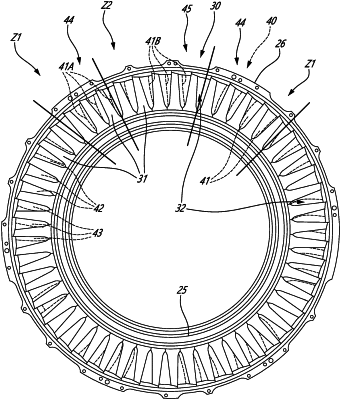| CPC F01D 9/04 (2013.01) [F01D 5/141 (2013.01); F01D 5/28 (2013.01); F01D 9/041 (2013.01); F01D 9/042 (2013.01); F01D 21/045 (2013.01); F01D 25/246 (2013.01); F05D 2220/323 (2013.01); F05D 2230/60 (2013.01); F05D 2240/121 (2013.01); F05D 2250/312 (2013.01); F05D 2300/121 (2013.01); F05D 2300/171 (2013.01)] | 18 Claims |

|
1. An aircraft engine, comprising:
an upstream stator having upstream stator vanes circumferentially distributed about a central axis; and
a downstream stator having downstream stator vanes circumferentially distributed about the central axis, the downstream stator located downstream of the upstream stator relative to an airflow flowing within a core gaspath of the aircraft engine, a number of the upstream stator vanes being different than a number of the downstream stator vanes, the downstream stator vanes including:
a first vane made of a first material, a major portion of a leading edge of the first vane being circumferentially overlapped by one of the upstream stator vanes such that the major portion of the leading edge of the first vane is not visible along a line of sight parallel to the central axis and along a direction of a flow through the aircraft engine, the major portion of the leading edge of the first vane including 50% or more of a span of the first vane, and
a second vane made of a second material having a greater stiffness, strength, and/or ductility than that of the first material, a major portion of a leading edge of the second vane being exposed to foreign object damage and visible through a spacing defined between two of the upstream stator vanes and along the line of sight parallel to the central axis and along the direction of the flow through the aircraft engine, the major portion of the leading edge of the second vane including 50% or more of a span of the second vane.
|